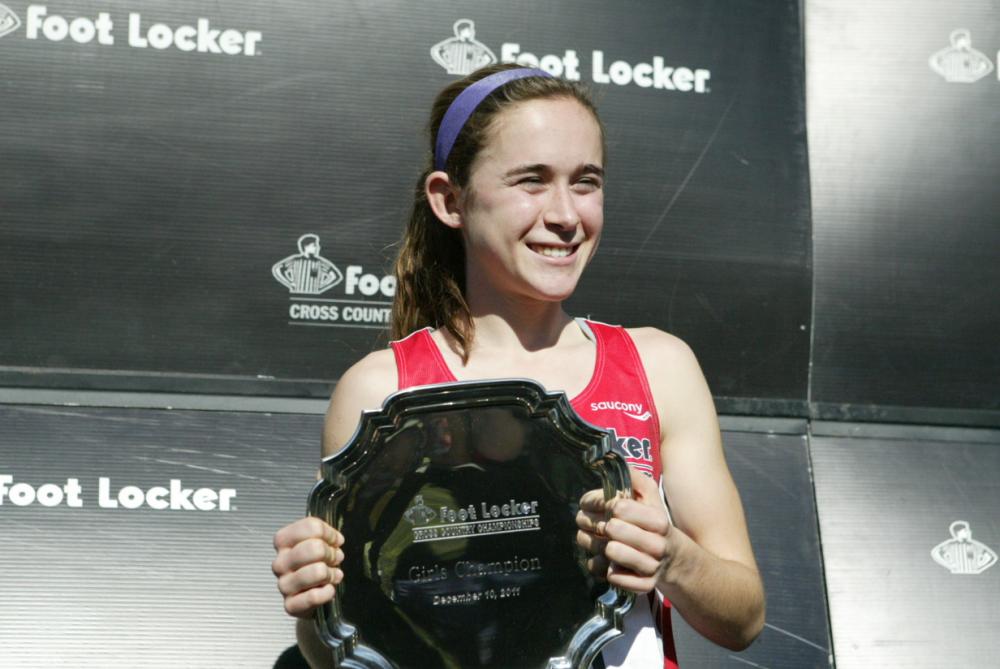Folders |
In Molly's Moment, A Blueprint For Those Who AspirePublished by
Molly Seidel: We Tremble At Her FeetBy Marc Bloom (Getty Images; Foot Locker photo by John Nepolitan) Be still my heart: Was that really Molly Seidel, the 27-year old from Wisconsin, the Heartland, the one athlete in the Olympic marathon who could make you laugh and cry at the same time, the one who’d run her first marathon at the U.S. Trials, who brazenly or foolishly challenged not only the Africans but the ghastly Sapporo heat that would fell many a great and then run stride-for-stride with Kenyan royalty through the half, through mile after mile, through humidity that took your breath away — through the world wide drumbeat of “Oh, no, what’s this crazy American kid doing? Will heat illness make her collapse like the Swiss who ran zig-zaggy to the finish at L.A. in ’84?”-- through the veil of shock and more shock to the actual Tokyo Olympics finish line in third place, 16 seconds behind the Kenyan champion and former world half-marathon record holder, 10 seconds behind the Kenyan runner-up and world marathon record holder and almost a minute ahead of the Ethiopian in fourth for the bronze medal?
Yes, yes, yes…It was Molly! And dare I say “our” Molly. With no less pluck, grit and daring-do than Joan Samuelson in her historic 1984 victory in the first women’s Olympic marathon (the Norwegians Ingrid Kristiansen and Grete Waitz were Joanie’s “Kenyan” rivals of the day), Seidel achieved the thought-to-be-impossible merely by staying up front, never wavering, never looking bad or in trouble, never looking like she was suffering, looking just as good if not better than the Kenyans themselves. Never mind a medal. That was more than impossible; a medal had all the logic of a presidential election conspiracy theory. I tremble at the image, fresh in our minds, at Seidel’s finish as though it was preordained. I shudder at the ease of it: the look of ease, of command, of subduing history, of dismissing three of the fastest women’s marathoners ever — yes, of course, the trio of Kenyans in the field of 88 starters. I am bewildered at the denial of suffocating heat that was not kind even to Kenyans with a million miles in their legs since running barefoot to school when barely out of diapers. How did Seidel do it? I have no idea. She had no cutting edge training program. She didn’t do anything unusual to acclimate to the heat. There was no hi-tech wizardry in her approach. She just ran. That may be the best part. A “regular” runner did this, oh joy to the world! In her NBC Olympic marathon commentary, the astute Kara Goucher said we all now live in Eliud Kipchoge’s World. I would add, we now also live in Molly Seidel’s Moment. The moment may take some time to settle in. Let it breathe, let it percolate. What possessed this woman who would have surprised many by finishing in the top 10; we expected the anguish of others, not a happy face emoji across the line. What depth of character emerged? In what field of study can we find answers? Seidel said she wanted “to stick her nose in.” Not good enough. We will want more. Molly, can you help us out? You studied anthropology and environmental science in college. Teach us. One thing we’ve learned is that to de-mystify the Kenyans you must run with them. The Kenyans remain the model, but instead of succumbing to their well-deserved throne, you, well… stick your nose in. Courtney Frerichs did it in the 3,000-meter steeplechase with a bold, even defiant, surge and wound up with the silver medal — which, when you think about it, was one of the best come-throughs for the American squad and much more than an historical footnote. Frerichs outran the Kenyan bronze medalist Hyvin Kiyeng, a former world steeple champion who took silver at Rio in 2016 as well as the daunting world record holder Beatrice Chepkoech, who on this day could do no better than seventh. It took a Ugandan national record by Peruth Chematai to beat Frerichs. In assessing the fields when the major championships arrive, shall we start to consider throwing PRs out the window, especially when the effects of humidity in thwarting a runner’s cooling apparatus are virtually impossible to predict? Kenya’s Olympic marathon winner, Peres Chepchirchir, came into the race as the two-time world half-marathon champion and former world record holder at 1:05:16 in 2020. Her marathon best was 2:17:16. In Sapporo, she ran 2:27:20. Her countrywoman in second, Brigid Koskei, was the woman who stunned the world with her 2:14:04 at Chicago in 2019, a pace of 5:07 per mile. Her Olympic time was 2:27:36, with Seidel practically on her heels and closing in 2:27:46. The third Kenyan in the field, Ruth Chepngetich, was the defending world marathon champion from Doha with a best of 2:17:08 who earlier this year shattered the world half-marathon by 29 seconds in 1:04:02. She was one of 14 women to suffer a DNF. In her youth, Chepngetich ran 10 kilometers a day back and forth to school in two round trips. In her youth, Molly Seidel put tiny University Lake High School on the map with her 12 state titles and some alpine skiing and field hockey in the mix. A promising takeaway from the Tokyo Games is that, after a long drought, star power has returned to American track and field. Allyson Felix, who needs no introduction, got the ball rolling. Add many more: the 400-meter hurdles champion and world record setter Sydney McLaughlin, the coolest cat under untenable pressure and with a glamour all her own; her rival Dalilah Muhammad, the defending Olympic champion, who also broke the world record and offers a fresh charm to McLaughlin’s take-no-prisoners aura; the gregarious 19-year-old 800-meter champion Athing Mu, whose born-to-run visage, take charge front-running and delectable poise are qualities to savor; Frerichs, who now has an Olympic silver medal to go with her World silver and U.S. record. The list goes on: Olympic champion pole vaulter Katie Nageotte, Olympic champion discus thrower Valarie Allman, consistent world number-one shot putter and Olympic champion Ryan Crouser, 400 hurdles runner-up Rai Benjamin placing behind the Beamonesque Norwegian Karsten Warholm while also breaking the world record… And Molly Seidel. She provides safe passage for all who aspire: the high school kids from nowheresville, those sorting out the complexities of body image, the first-time marathoners, the newbies entering a fearsome international spotlight; the predicted also-rans considered lucky just to be in it. With next year’s COVID-delayed World Athletics Championships in Eugene, Oregon, the star power should only acquire that much more luster as the Americans compete on home turf. Who knows if the athletes will bask in Eugene’s cool forest breezes or whether the Death Valley heat wave that swamped the Olympic Trials in June will emerge again. Either way, I think we can expect Seidel and her American compatriots — stars and would-be stars alike — not to play it safe. # Marc Bloom has covered 23 World Championships in outdoor track, indoor track and cross-country, including several Olympic Games. In 1992 at Barcelona and 1996 at Atlanta, Marc rode a bicycle at the head of the marathon fields as an “official Olympic vehicle” reporting for NBC. More news
1 comment(s)
|








 Was that really you, Molly? The Molly who won the Foot Locker high school championships, collected four NCAA titles at Notre Dame, qualified for the Olympic Trials with a half-marathon, has a coach not on the payroll of a major shoe company in Oregon (and a former coach who in high school was kicked out of the Foot Locker nationals for delinquent behavior), and has been open and honest about one of women’s running’s most severe challenges — the prevalence, even with all our knowledge, research and foresight, of disordered eating and resulting injuries?
Was that really you, Molly? The Molly who won the Foot Locker high school championships, collected four NCAA titles at Notre Dame, qualified for the Olympic Trials with a half-marathon, has a coach not on the payroll of a major shoe company in Oregon (and a former coach who in high school was kicked out of the Foot Locker nationals for delinquent behavior), and has been open and honest about one of women’s running’s most severe challenges — the prevalence, even with all our knowledge, research and foresight, of disordered eating and resulting injuries?